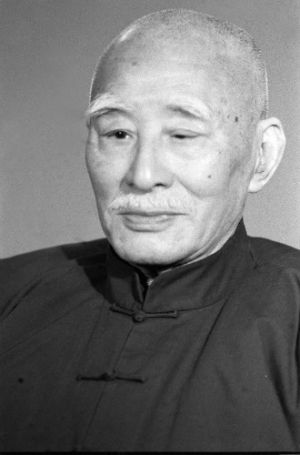Ye Shengtao
Ye Shengtao (Chinese: 叶圣陶) was a Chinese educator and writer.
Ye Shengtao was born Ye Shaojun on October 28, 1894 in Suzhou, Jiangsu Province. His father was employed at a landlord's house as a bookkeeper, barely eking out a living. Ye began his schooling at the age of six under a private tutor. He entered a primary school six years later. In 1907, he was admitted to a high school, and upon graduation in 1911 he took a teaching job at a primary school in his hometown.
In 1914, however, he lost his job and was forced to stay at home for one year, during which time he wrote a dozen or so short stories in classical Chinese. Though ancient in form and language, these pieces, published in the magazine Saturday, were actually realistic portrayals of contemporary life in China and very different from the genre of "for amusement only" then in vogue.
In late 1915, he left for Shanghai, where he taught Chinese and, in the meantime, complied textbooks for the Commercial Press. He married Hu Molin in 1916 and moved to Luzhi, a town about 12 miles west of Shanghai, where he taught at a higher primary school. There, he and some of his friends began to use new teaching methods and to spread new ideas among the pupils.
His first short story written in the vernacular, "Random talks at a Spring Dinner Party," was published in Women in 1918. It was a tribute to able women in a society that was dominated by men. The following year, he joined the New Tide Society, a club started by a group of Beijing University students, and became a regular contributor to its publication New Tide. Allusions to the October Revolution in Russia or the May 4th Movement in China were found everywhere in his stories and essays. He was one of the founders of the Literary Research Society in 1921 along with Zheng Zhenduo and Mao Dun. Most of his works during this period were published in either Short Story Monthly or The Literature, a periodical published every 10 days. After he taught at Hangzhou No.1 Normal School in Hangzhou at the request of Zhu Ziqing, he became an editor with the Commercial Press in Shanghai from 1923 until 1930, when he transferred to Kaiming Book Company. During the War of Resistance Against Japan, he moved with his family inland and earned a living by teaching at schools and colleges. In 1946, he returned to Shanghai and resumed his editorship with Kaiming.
In 1949, he left Shanghai for Beijing via Hong Kong to attend the first Chinese People's Political Consultative Conference, at which he was elected a member of its national committee. He was then assigned to be vice-minister of education and director of the People's Education Publishing House in addition to his directorship with the Central Institute for Culture and History. Ye Shengtao died on February 16, 1988.
A prolific writer, Ye holds a prominent place in the history of modern Chinese literature. Apart from his poems and plays published in the early 1920s, his Scarecrow, published in 1923, has been generally recognized as the first fairy tale in its authentic sense ever written in China. His famous essay "Torrential Rain on May 31" vents his moral indignation at the incident that had taken place the previous day in 1925. In 1928, his novel Schoolmaster Ni Huanzhi portrays the transformation of the petit bourgeoisie. His miscellaneous essays were mostly allegorical, the most typical ones being "Lotus Root and Water Shield" and "Where There's No Insect in Autumn."
Most of his short stories are realistic, such as "How Mr. Pan Weathered the Storm," an elaborate delineation of the educated, and "A Year of Good Harvest." These works helped earn him the reputation of master of the Chinese language.
